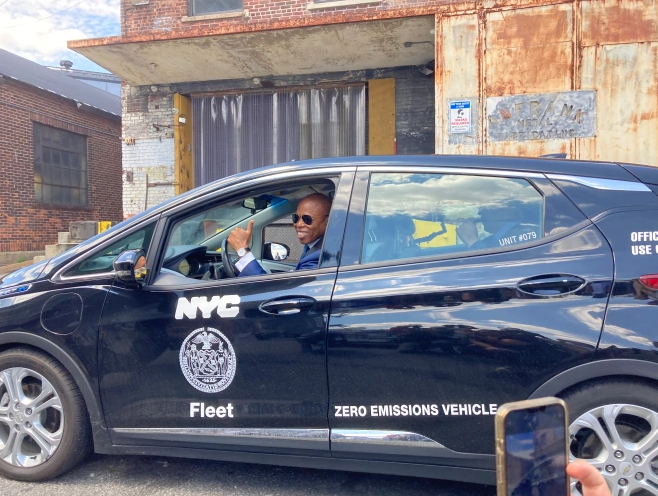A tiny number of city employees driving taxpayer-funded government cars will have no choice but to slow down thanks to speed governors that will soon be installed in 0.2 percent of the city fleet, Mayor Adams announced on Thursday — before admitting that the pilot program exempts his own SUV along with NYPD squad cars and cops’ personal cars.
“We are urging New Yorkers to slow down, so we have to start with our fleets first,” Adams said at the Brooklyn Navy Yard as he stood next to a city vehicle equipped with the new technology. “Clearly you see the correlation between these injuries and fatalities are connected to aggressive, fast driving — we want to make sure we lead from the front. Exempted currently from this technology are emergency vehicles and my vehicle at this time.”
The new technology, known as intelligent speed assistance, can adjust to the local speed limit. For example, drivers will barely be able to top 15 miles per hour if that’s the speed limit on that particular street, according to Keith Kerman, DCAS Deputy Commissioner and Chief Fleet Office.
“If you try hard to get to 16, then it’ll draw you back, not allow you to accelerate,” he said.
Just nine agencies are included in the six-month, 50-vehicle pilot program: the Parks Department, Department of Corrections, Department of Transportation, Department of Environmental Protection, the Business Integrity Commission, Taxi and Limousine Commission, Department of Citywide Administrative Services, Housing Preservation and Development, and the Mayor’s Street Condition Observation Unit (SCOUT). As of fiscal year 2022, the city’s on-road fleet — including SUVs, sedans, pickup trucks, vans, and dump trucks — contains 24,439 vehicles.
Beyond the city’s vehicle fleet, tens of thousands of city workers, many of them with parking placards, drive to work every day before then swapping their personal car for a city car. Those drivers — including police officers who disproportionately drive their private vehicles in a reckless fashion, as Streetsblog revealed in an investigation — will not be affected by the pilot program..
Adams defended the exemption to squad cars and his own SUV, saying he has a duty to New Yorkers to arrive at the scene of whatever emergency happens in any corner of the city as quickly as possible.
“Anything can happen in this city any time of night that may cause us to move at a non-traditional rapid speed — if I have an explosion, if I have a plane landing on the river, if I have any type of emergency, this is a real city with real problems and real issues and I don’t need for you to be at the scene saying, ‘Why did it take the mayor so long to get there?’” he said, adding that he does caution his drivers to slow down. “We will be smart when we drive with this attachment or without this attachment. We’re gonna be safe as we move through the streets, but in a real world like New York, there are moments where we have to get some place in a hurry to make these decisions that happen in the city.” (Streetsblog has run the plates on two SUVs that ferried Adams to recent events and neither had a camera-issued speeding or red-light ticket.)
But it’s no secret that many city employees hit the gas behind the wheel — like the two DOT trucks we ran through How’s My Driving at a recent press conference. Even the new car the mayor posed with on Thursday was nabbed for speeding in Queens on June 3.
Reminder that the car was being chased by cops at the time https://t.co/PsymDBN80e
— marc tracy (@marcatracy) August 10, 2022
And for the past several years, the city has had to shell out tens of millions of dollars as a result of settlements to victims of crashes caused by city workers. In fiscal year 2021, which runs from July 1, 2020 through June 30, 2021, the city coughed up $138.5 million to settle 4,143 cases involving a government employee who hit someone — or something — with a city car.
But in the last two years, speeding by drivers of city vehicles is down 52 percent, and injuries from crashes are down 20 during the same time period, according to Department of Citywide Administrative Services Commissioner Dawn Pinnock. The new pilot program is the last initiative to be implemented as part of the city’s so-called Safe Fleet Transition Plan.
“With our defensive driving courses, telematics, surround and dash cameras, and vehicle safety systems, safety is at the heart of the city’s fleet. We’re already making strides,” said Pinnock. “We hope this pilot will build upon the success and reinforce New York City’s position as the leader in fleet management.”
And advocates cheered the new technology to slow drivers down, albeit a small percentage. But it’s a start, said Danny Harris, executive director of Transportation Alternatives.
“We know that 80 percent of the fatalities on our roads in New York City occurred because of speeding,” said Harris. “We look forward to seeing this pilot expand to every vehicle in the fleet and more vehicles across New York City.”






